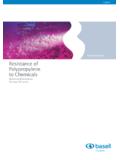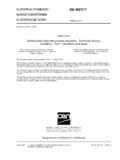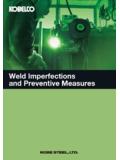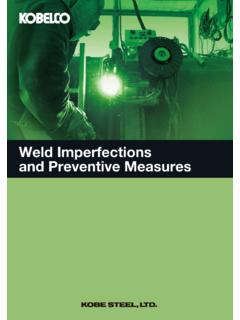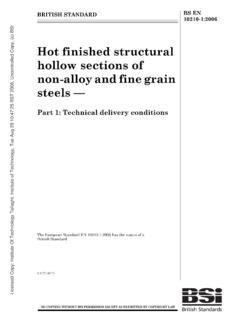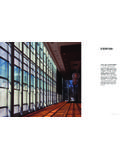Transcription of Welding Conditions for KYNAR PVDF
1 Basic Welding Principles In order to produce a high quality weld three perimeters must be controlled, they are: TEMPERATURE----PRESSURE----TIME The temperature must be controlled within the specified range in order to produce the proper melting of the KYNAR pvdf . The pressure in the weld must be properly controlled to avoid forcing the melted KYNAR pvdf out of the weld interface, excessive pressure. Inadequate pressure in the weld interface will not provide adequate mixing of the melt. The time must be controlled to provide uniform heating throughout the weld zone. The materials low thermal conductivity slows the heat transfer. After reaching the proper melt Conditions slow cooling is necessary to reduce stress and permit the intermolecular diffusion of the polymer to take place. The weld will change physical characteristics for up to 12 hours after the weld is produced.
2 Testing of welds for physical characteristics such as tensile, bend angle, etc. prior to 12 hours after completion of the weld will produce erroneous results. In order to produce the highest quality weld the surfaces to be welded must be clean. The surface should be scraped just prior to every weld pass. Wiping with a solvent only spreads the contamination! The weld zone should allowed to cool to ambient temperature prior to the next weld pass. If the weld zone is not allowed to cool excessive stress will result. This may cause distortion of the weldment. Welding Conditions for KYNAR pvdf The Welding of KYNAR pvdf can be performed using conventional hot gas Welding equipment. It is highly recommended that automatic temperature Welding equipment be utilized. This type of equipment greatly reduces the possibility of substandard welds due to temperature variations during the Welding process.
3 The Welding process requires a skilled operator that has shown by testing of his sample welds that he is capable of maintaining the proper pressure on the weld and maintain the proper uniform speed necessary to produce a suitable weld . A suitable weld can be defined as one capable of meeting the Deutscher Verbena Fur Schweissen Und Verwandte Verfahren (DVS) requirements for welder certification. The DVS standards for plastic Welding are readily available on CD ROM in German, English and French. The values in the table Hot Gas Welding Conditions are the current Conditions accepted by the DVS as the optimal Welding perimeters. The Welding area should be well ventilated so that heat and fumes generated during the Welding process are drawn away from the welder. Drafts, excessive air movement and similar Conditions that would cause the weld to cool rapidly must be avoided.
4 The weld area must be clean and free of dust and plastic particles that will be attracted to the weld . 1 Hot Gas Welding Conditions Force2 3 mm Force2 4 mm Welding Process Welding Temperature oC1 Vol. Air L/ Min. N Lbs. N Lbs. Welding Speed Cm/min. Fan Welding WF 300-320 (570-610oF) 40-60 10-15 15-20 10 15 High Speed WZ 365-385 (690-725oF) 40-60 12-17 3-4 25-35 6-8 25 - 40 Note 1- Temperature measured 5 mm inside main outlet of the Welding tip. Note 2- Force applied to weld zone through Welding gun. weld Qualification and Evaluation The Welding Conditions should always be recorded. Table 1 is an example of a form that can be used to record the Welding Conditions . The use of data recorded on this document during the production of welder qualification samples should be used to exactly reproduce welds in subsequent Welding applications.
5 Welders of critical components should be DVS Certified according to the requirements in DVS 2212-1 Subgroup 1-7 for KYNAR pvdf sheet and/or Subgroup 1-8 for KYNAR pvdf pipe or qualified using the DVS 2212-1 as a guideline. If certification is not practical the welder should be qualified using the test requirements in DVS 2212-1 as a guideline. Visual evaluation of KYNAR pvdf welds should be done using American Welding Society (AWS) AWS G , latest revision, available from Global Engineering Documents (800-854-7179). This document provides visual representations of weld defects and provides standards for the appearance of thermoplastic welds. The total stress in a weldment should be kept to a minimum. Stresses are produced when the semi-finished product is manufactured, during any forming process and during the Welding process. These stresses can be greatly reduced by careful attention to the entire process.
6 Whenever the KYNAR pvdf is heated the heat should be controlled within appropriate guidelines. Avoid uneven heating. Cooling should be slow, uniform and not forced by fanning. Slow uniform cooling reduces stress. Welds should be allowed to cool to ambient temperature prior to subsequent passes. 2 HOT GAS Welding RECORD Identification_____ Welder name _____ Date _____ Welding equip. Mfg. _____ Model _____ Identification # _____ WORKPIECE WEATHER Conditions weld ROD Welding DATA RUN NUMBER Type of weld Thickness mm Sun Dry Humid Wind Temp Dia. mm Speed cm/ min Gas Psi Gas L/ min T oC No. of beads Table 1 3 Lining Skills If the fabrications are dual laminate construction, a complete working knowledge of ASME specification RTP-1, for reinforcements is recommended.
7 Although this specification does not presently address dual laminate construction details, an ASME subcommittee is reviewing the document relative to dual laminate construction. In constructions where the lining of existing structures are being performed, the welder must possess a working cognizance of adhesives that are suitable for the tank Conditions , , temperature, pressure, etc. The adhesives typically utilized include epoxies, elastomerics and contact adhesives. Each adhesive system has relative merits and flaws. The adhesive system should be carefully considered as part of the entire lining job. Epoxy type adhesives should have 3-10% elongation after full cure (minimum recommended value). This is more important than adhesion values, as most exceed the capabilities of the backed lining system. Elastomeric and contact adhesives often have use temperatures lower than the lining.
8 This will limit the system upper use temperature to that of the lowest rated component. Evaluation of Welder (1) The Welding inspector must evaluate the weld procedure and test specimens. Specimens must be evaluated on the basis of appearance of the weld and physical quality of the weld . Welds must be evaluated in accordance to the standards. Grades for compliance with standards should be: 2 - good - no defects 3 - satisfactory - minor defects 4 - poor - unacceptable defects Both 2 and 3 are considered acceptable grades; grade 4 is not acceptable for certificates. The evaluation of the weld appearance should take place prior to cutting the specimen for physical testing. 4 weld Inspection Appearance Guidelines Poor appearance (unacceptable) of welds (a) Non-uniform width of weld bead, height of bead or penetration of weld .
9 Cause: 1. Uneven pressure 2. Non-uniform weld rod feed 3. Poor temperature control gas flow rate non-uniform heat control unacceptable poor control of weld gun angle or speed 4. Specimen not properly held in place Stress cracking in weld area Causes: 1. weld degradation excessive heat improper knowledge of plastic type 2. Stress in weld rod 3. Improper weld rod feed inducing stress 4. weld temperature incorrect Improper penetration or porous welds Causes: 1. Improper weld speed 2. Improper preheat of sheet gun angle defective or dirty weld tip gun speed excessive 3. Improper weld rod diameter for thickness 4. Welding over starts and stops without proper preparation 5. Improper gap or bevel 6. Poor fusion of rod Improper temperature Dirty rod or tip Improper rod size 5 weld Evaluation - Appearance Criteria (1) The following points should be observed during and after Welding .
10 The evaluation of these criteria should be listed on the test score sheet according to paragraph of evaluation of welder. Some typical unacceptable defects are listed above in paragraph 1. Poor Appearance of Welds. (2) weld Appearance: Bead Formation Discoloration of Sheet or Rod Stretching or Deformation of Rod Straightness of weld Notches or Side Beads around weld Heat affected Zone Lumps or Projections in weld Penetration of weld Porosity of weld Fusion at Root Alignment and Movement of weld Sample Fill of Bevel weld Defects Design of the Welding Seam Reason for Failure No bead, Welding rod is layed round Temperature is too low, Welding force is too low, Welding speed is too high. Welding rod is flat, bead is only on the Welding rod. Irregular heating up, basis material too cold.


